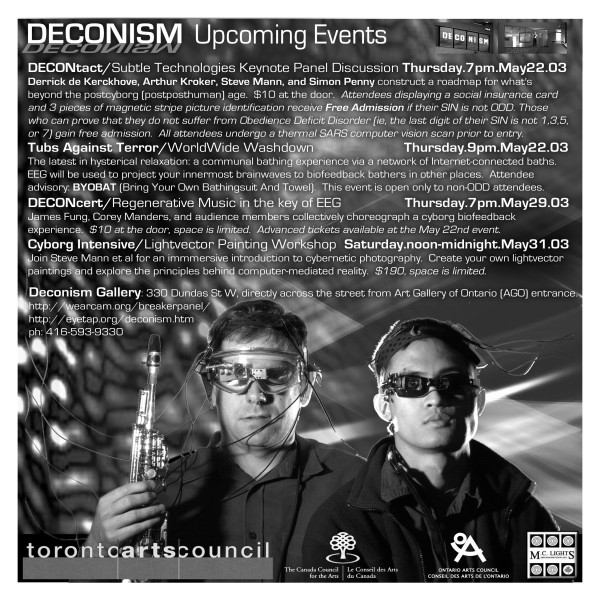Thursday, 2003 May 22
Deconism Gallery/Museum/Arts Complex,
330 Dundas Street West, Toronto, Ontario
Entrance directly across the street from the main entrance
to Art Gallery of Ontario (AGO)
- 7pm: Cyborg DECONtact,
Opening Keynote, Panel Discussion, with
Derrick de Kerckhove, Arthur Kroker, Steve Mann, and
Simon Penny.
- 8:30pm: Opening Reception:
- CyborgLoggers ("gloggers") in the Post-Cyborg Age,
by Steve Mann, James Fung, Chris Aimone, Orion Gural,
David Elliott, and Gianluca Baccanico, curated by
Stewart Morgan;
- Bedlam Telekinesis by Bill Vorn and Simon Penny,
curated by year01.
7pm Panel discussion is $10 admission at the door.
Attendees may optionally choose to bring a social insurance card
with 3 pieces of magnetic stripe
picture identification for Expediated Safe and
Free Admission, together with VIP treatment as
Registered non-terrorists, if their SIN is not
ODD.
Those who can prove that the last digit of their SIN is
not {1,3,5, or 7} will get free admission to the evening's events,
as well as be allowed to
attend a special exhibit reserved only for those who can prove that
they are not carriers of Obedience Deficit Disorder (ODD).
All attendees must undergo scan by a thermal SARS camera computer vision system
prior to entry.
8:30pm reception is free.
Cyborg DECONtact

Opening Keynote, Panel Discussion
Derrick de Kerckhove, Arthur Kroker, Steve Mann,
and Simon Penny
It was once said that we've already become cyborgs, whether through clothing,
jewellery, and personal effects, or through the convergence of cellphones,
digital cameras, and computers (or pocket organizers) into a single device.
The cyborg ("glog"), with free-running personal
stream-of-deconsciousness videographic weblog is now mainstream,
whether by Rogers CamPhone, or EyeTap eyeglasses.
But the cyborg age has come and gone.
McLuhan argued that that which is obsolete becomes art(ifact), so when
the cyborg (and with it, postmodernism -- 1926-2001)
becomes art(ifact) --- i.e. the
cyborg becomes obsolete --- we have entered the post-cyborg
(and postpostmodern/postpoststructuralist) age.
In the postcorporeal age, we enter the era of
art-of-the-mind
(the mind is both art and artifact, and therefore obsolete),
and thus we might say that saying that "the body is obsolete" is obsolete.
This panel will try to construct a roadmap for what's next
beyond the postcyborg (postposthuman) age, and thus define a
neutral ground for
subtle technologies, with a special emphasis on
the
Legal, Ethical, and Policy issues associated with wearable computers,
virtual environments, and computer mediated reality.
Bios
Derrick de Kerckhove
is the Director of the McLuhan Program in Culture
and Technology at the University of Toronto, Canada. Among his
publications, The Alphabet and
the Brain (1988), Brainframes, Technology, Mind and Business (1991),
Les transinteractifs (1990), some such as The Skin of Culture (1995) have
appeared on best-seller lists and translated in a dozen languages, e.g.
Connected Intelligence (1997), and The Architecture of Intelligence
(2001). His next book, McLuhan for Managers (Pearson Canada, October
2003) is co-authored with Mark Federman.
Arthur and Marilouise Kroker are two of the world's
leading media intellectuals. The CBC has placed them among the world's
most influential futurists, and the British magazine ID has editorialized:
'Their work says more about the New Flesh of the data sphere than all
of David Cronenberg's films combined.'
The Krokers have co-authored many books. In collaboration with
multimedia musicians, they have produced three music CDs with stories
from their books. The Krokers have made a unique contribution to
thinking about media by using the internet, compact discs, videos and
fiction to supplement their ground breaking intellectual work.
Steve Mann
is currently a faculty member at University of Toronto.
He has written over a hundred research publications
and is frequently the keynote speaker at scholarly and industry
conferences, lecture series and colloquia.
His work has been exhibited in numerous museums around the world,
including MoMA, Stedelijk Museum (Amsterdam), Science Museum (U.K.),
Triennale di Milano, Oklahoma City Art Museum,
Austin Museum of Art, and San Francisco Art Institute.
He received his PhD degree from M.I.T. in 1997 for work including the
introduction of Humanistic Intelligence.
He is also inventor of the Chirplet Transform, a new mathematical framework
for signal processing, and of Comparametric Equations, a new mathematical
framework for computer mediated reality, and is
author of Intelligent Image
Processing (Wiley, 2001), and
CYBORG (Randomhouse Doubleday 2001),
which, together with his documentary
ShootingBack,
inspired the 35mm feature length motion picture film
Cyberman.
Simon Penny is an Australian artist, theorist and teacher in
the field of Interactive Media Art. His art practice consists of interactive and
robotic installations, which have been exhibited in the US, Australia
and Europe. His current project "Traces" is a telematic interactive
environment using networked CAVEs with machine vision sensing in each
CAVE. This project is a development on directions pursued the machine
vision driven interactive digital video installation "Fugitive", first
shown at ZKM Multimediale5, Oct97 and again at EMAF98 (European Media
Art Festival, Osnabruck). Other recent projects include the emergent
complexity sound installation Sympathetic Sentience (I, II and III,
with Jameison Schulte) and the autonomous robotic artwork Petit Mal.
Other upcoming events at Deconism
Gallery/Museum/Arts Complex:


